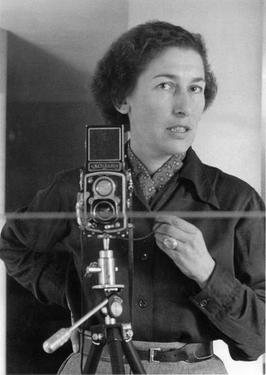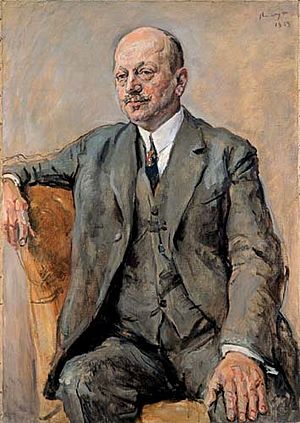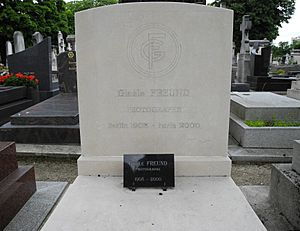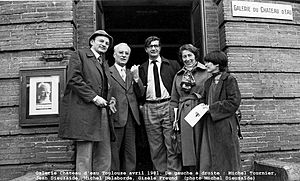Gisèle Freund facts for kids
Quick facts for kids
Gisèle Freund
|
|
|---|---|

Self-portrait
|
|
| Born | 19 December 1908 |
| Died | 31 March 2000 (aged 91) |
| Nationality | German-born French |
| Education | University of Freiburg, University of Frankfurt, and the Sorbonne |
| Known for | Photography |
| Spouse(s) |
Pierre Blum
(m. 1935; div. 1948) |
Gisèle Freund (born Gisela Freund; December 19, 1908 – March 31, 2000) was a famous German-born French photographer. She was known for her amazing documentary photography and her portraits of writers and artists.
Gisèle Freund was one of the first to use the Leica Camera for photojournalism. This camera could hold a lot of film, making it great for capturing many moments. She also experimented with early color films like Kodachrome and Agfacolor. This helped her create a unique style of "candid portraiture," meaning she captured people naturally.
Her most famous book, Photographie et société (1974), talks about how photography is used and sometimes misused. In 1977, she became the president of the French Association of Photographers. She even took the official portrait of French President François Mitterrand in 1981.
Gisèle Freund received high honors in France, including the Officier des Arts et Lettres in 1982 and the Chevalier de la Légion d'honneur in 1983. In 1991, she was the first photographer to have a major show at the Musée National d'art Moderne in Paris. She is buried in Montparnasse Cemetery in Paris.
Contents
Life Story
Gisèle Freund was born on December 19, 1908, in Berlin, Germany. Her family was wealthy and her father, Julius Freund, loved art and photography.
He bought Gisèle her first camera, a Voigtländer, in 1925. Later, he gave her a Leica when she graduated in 1929.
In the early 1930s, Freund studied sociology and art history at universities in Germany. She became part of a student group that supported socialism. She believed photography could help her share her ideas.
One of her first photo stories was about anti-fascist students marching in 1932. These students were often attacked by Nazi groups. Her photos showed important people like Walter Benjamin and Bertolt Brecht.
In March 1933, after Adolf Hitler came to power, Gisèle had to leave Germany. She was a socialist activist and Jewish, so it was dangerous for her. She escaped to Paris, France, with her photo negatives hidden around her body.
In Paris, she continued her studies at the Sorbonne. She also continued her friendship with Walter Benjamin. She famously photographed him reading at the National Library.
In 1935, Gisèle met many famous French artists and writers. She became friends with Sylvia Beach and Adrienne Monnier, who ran famous bookstores. To stay in France legally, Freund had a "marriage of convenience" with Pierre Blum. They later divorced in 1948.
Adrienne Monnier helped Freund meet many artists and writers. These people became her most interesting subjects for photos. In 1936, Freund became famous internationally. Her photo story "Northern England" was published in Life magazine. It showed how the Great Depression affected England. Life was one of the first magazines to publish color photos, which was new at the time.
In 1938, Adrienne Monnier suggested Freund photograph James Joyce, a famous writer. Joyce usually didn't like being photographed. But he was impressed by Freund's work and let her take his picture. Over three days, she captured some of the most personal photos of Joyce.
In 1939, Freund also took iconic color photographs of Virginia Woolf and her husband. These photos are now in the English National Portrait Gallery. Woolf even changed her clothes to match the colors in the photos.
On June 10, 1940, as the Nazis were about to invade Paris, Freund fled to a safer part of France. Her husband, Pierre, was captured but escaped to fight in the French Resistance. As a Jewish woman and socialist, Gisèle was in great danger.
In 1942, with help from friends, Freund escaped to Buenos Aires, Argentina. There, she met and photographed many great writers and artists, like Jorge Luis Borges and Pablo Neruda. She also started a publishing company and worked for the De Gaulle government in exile.
In 1947, Freund joined Magnum Photos, a famous photo agency. But in 1954, the U.S. government declared her persona non grata (an unwelcome person) because of her socialist views. She had to leave Magnum.
In 1950, her photos of Eva Perón for Life magazine caused problems. The photos showed Perón wearing many jewels, which went against the government's message of saving money. Life magazine was banned in Argentina, and Freund had to leave the country again with her negatives.
She moved to Mexico and became friends with artists like Diego Rivera and Frida Kahlo. In 1953, she moved back to Paris for good. Throughout her career, she worked on over 80 photojournalism assignments for magazines like Life and Time.
From the 1960s onwards, Freund continued to write and her reputation grew. She is now known as one of the best portrait photographers of the 20th century. When she died, French President Jacques Chirac called her "one of the world's greatest photographers."
Famous Works
In 1936, Gisèle Freund photographed the effects of the Great Depression in England for Life magazine. One of her early famous works shows her friends Walter Benjamin and Bertolt Brecht at a political protest in Germany. This was just before Hitler came to power.
In 1938, Freund photographed James Joyce in Paris. Joyce really disliked being photographed. During one session, he accidentally hit his head and started bleeding. He joked, "I'm bleeding. Your damned photos will be the death of me!"
Later, Freund was in a taxi crash and her cameras broke. She called Joyce and blamed his "bad Irish spell." Because Joyce was superstitious, he invited her back for more photos. One of these photos was used on the cover of Time magazine in 1939. These photos were later published in a book called James Joyce in Paris: His Final Years.
Freund became famous for her portraits of many literary geniuses. These included Samuel Beckett, Virginia Woolf, and George Bernard Shaw. She was great at capturing their true personalities.
In 1981, she took the official portrait of François Mitterrand, who became the President of France.
Gisèle Freund was skilled at showing the true nature of her subjects. She paid attention to their hands, body language, and clothes. She often read their books and talked with them for hours before taking a picture. This helped her connect with them and photograph them naturally.
What Gisèle Freund Said
From "Photographer" (1985)
- "For a writer, his portrait is the only link he can establish with his readers. When we read a book whose content moves us, we are interested to look at the author's face."
- "This image is thus very important to the man of letters. He prefers a photographer in whom he can have confidence."
From Photography & Society
- "The lens, the so-called impartial eye, actually permits every possible distortion of reality. The character of the image is determined by the photographer's point of view."
- "The importance of photography does not rest primarily in its potential as an art form. It is in its ability to shape our ideas, to influence our behavior, and to define our society."
- "In our technological age, the photographic industry has grown hugely. This is because the photograph meets modern man's pressing need to express his own individuality."
- "Although the first inventor of photography, Nicéphore Niépce, tried desperately to have his invention recognized, his efforts were in vain. Few people know his name today. But photography, which he discovered, has become the most common language of our civilization."
- "When you do not like human beings, you cannot make good portraits."
Exhibitions
Gisèle Freund's work was shown in many exhibitions around the world. She had private viewings for people like James Joyce. Her first public exhibition was in Paris in 1939.
She had shows in Buenos Aires, London, New York, Tokyo, and Berlin. A major retrospective of her work was held at the Centre Georges-Pompidou in Paris in 1991. Her photographs continue to be exhibited today.
Books by Gisèle Freund
Gisèle Freund wrote several books about photography and her experiences. Her first book, "La photographie en France au dix-neuvieme siècle" (French Photography in the 19th Century), was published in 1936.
Other notable books include "James Joyce in Paris. His final years" (1965) and "Photographie et societe" (Photography and Society) (1974). She also published "Le monde et ma camera" (The World and My Camera) (1970) and "Memoires de l'Oeil" (My Eye's Memories) (1977).
Awards and Honors
- 1989: Doctor honoris causa, National Museum of Photography at Bradford University
- 1983: Chevalier de la Légion d'Honneur (France's highest honor)
- 1982: Officier des Arts et Lettres (France)
- 1980: Grand prix national des Arts pour la Photographie (France)
- 1978: German Society's cultural photography prize (Germany)
- 1977: Elected President, French Federation of Creative Photographers (France)
Film and Television
Gisèle Freund was featured in the 1996 documentary Paris Was a Woman. In this film, she talked about her experiences in Paris during the 1930s. She also appeared in a German TV series called Zeugen des Jahrhunderts (Witnesses of the Century) in 1979.
|
See also
 In Spanish: Gisèle Freund para niños
In Spanish: Gisèle Freund para niños




